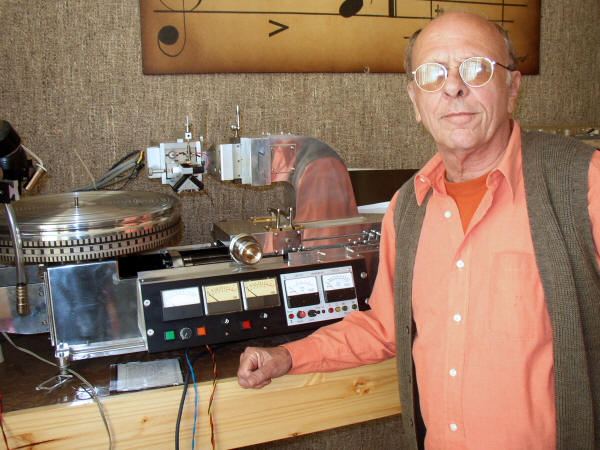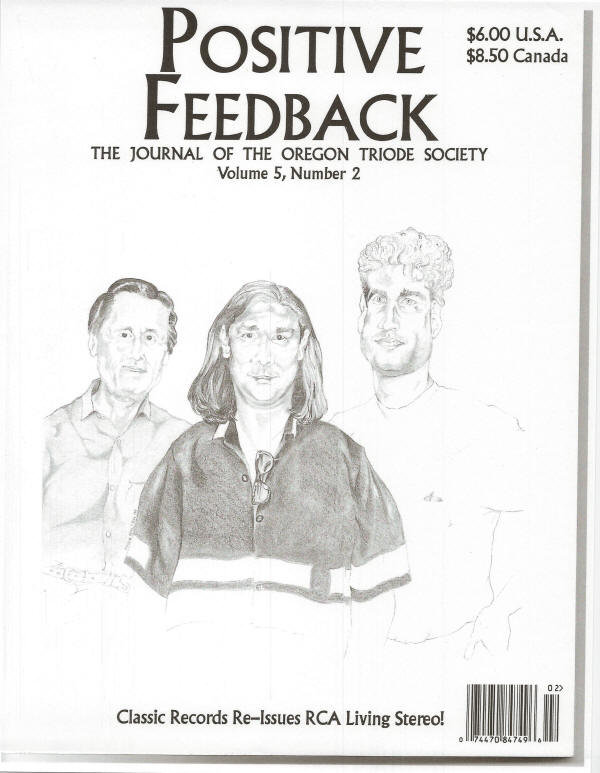|
You are reading the older HTML site
Positive Feedback ISSUE 65
On the passing of David Manley… and Manley's first
article for Positive Feedback
David Manley, with his cutting lathe. [Photograph by Kathleen Benveniste; image processing by David W. Robinson] Yes, I do remember David; pretty well, in fact. It's not like David Manley was an easy person to miss or forget. When he first got in touch with me sometime in 1993 or so, he was interested in contributing some articles from time to time on tube electronics, and jousting with the Single-Ended Triode (SET) crowd whose vogue at that time he considered to be a fad… and a bad one, at that! I told him that I would be glad to publish his comments, provided that he didn't write infomercials or become ad hominem in his arguments. He agreed readily, and we launched a brief but bracing series of articles. David was always willing to share his ideas and opinions, and I believed that Positive Feedback and our readers would be the better as a result. As it turned out, I was right. David's blunt appraisals attracted a response from Peter Qvortrup of AudioNote U.K., who probably couldn't have been further from David's framework in his pursuit of audio excellent via their SET designs. They began a kind of "point-counterpoint" exchange of articles in PF, tangling a bit, but over time finally reached a point of having a kind of grudging respect for one another's positions. They did not agree with one another, but at least they were able to disagree agreeably. Things could have been worse, I guess. As I thought about David's passing, I decided to re-publish his very first article with us. Letting David speak in his own words, and his own inimitable way, is far better than anything I could do to evoke his presence. Take it, David…
From the Positive Feedback print archives, Vol. 5, No. 2, 1994 The Technology of Topology [David Manley is President of Manley Laboratories, Inc.] Foreword Your editor David Robinson invited me to submit some material for publication—I am honored to comply. I will try to inform and entertain you without abusing your hospitality by slipping in trumpet-blasts for my company Manley Labs. We'll do that in paid-for advertising. If occasionally a reference to my design work occurs, please know it is relevant to the matter at hand. THE TECHNOLOGY OF TOPOLOGY (WITHOUT APOLOGY) I wish it were not so, but clearly we all notice that certain ideas, concepts and focus-points move around like dress-lengths in the fashion business: hot today, cool tomorrow, and dead the day after—only to be revived again much, much later! There is a fashion too in what constitutes "today's most desirable sound." We went through Quadraphonic two decades ago and now it's back in various forms of "surround sound" with the recent accent on home theatre. And this fashion syndrome is not confined to Audiophiles—it happens a lot in the professional recording industry too. Instead of "I want the greatest (microphone preamp) ever designed" it is more often "I want the sound of so-and so's vocal (guitar, echo, etc.) on their newest album!" Put into clear and truthful terms, the search CAN actually become one for an EQUALIZER of some kind -but NEVER, NEVER identified as such! This even extends into the exotic cable arena with varying capacity, resistance, current-carrying ability, and even downright inductivity in some of the more complex weaves! At last, these are now being discussed out-of-the-closet as fine-tuning equalizers... well HELL, one must view it this way if a particular type induces frequency-response variations in such-and-such an interface combination. And then there is the fashion-factor in the circuit topology itself of amplifiers and preamplifiers—I'll keep it in the tube domain though it occurs in that other technology also—and how the fashion rotunda of loudspeaker types relates to amplifier topology, especially where the amount of actual power is concerned. Let us first go back a little in time and examine how things progressed: a. Single-ended amplifiers (and 'single' all the way through) coupled with interstage transformers; very modest power—call it 5 watts. b) Fully transformer-coupled push-pull amplifiers, modest power... say 10 watts, unbalanced or "single" phase input. c) Resistance coupled push-pull amplifiers: the British "Williamson" design obviously jumps to mind as the early benchmark resistance-coupled true high-fidelity amplifier which eliminated the sonic signature—read aberrations—of interstage transformers. Unbalanced input with phase-splitter (cathode-follower type, not the best), a self-biased (cathode resistors therefore), pair of output tubes with imperatively excellent output transformer design, up to 20dB's of negative feedback, some more power at 15 watts and used with EFFICIENT (95dB say) 16 ohm LOUDSPEAKERS of various persuasions. d) Good (American mainly) resistance-coupled designs but with FIXED bias (separately generated negative volts supply for the output grids) enabling 50, 75, and even 100 watts from a single pair of 6550's or KT88's. Commonly single-ended input, phase-splitter etc. Somewhere in here enters the progress of loudspeaker development especially as affected by the "other technology." Amplifiers that were nice and cheap to manufacture, no output transformer, no glass tubes. These beasties, current related as they are, produce even more 'bang for the buck' into lower impedance speakers. 8 ohms seemed to become the new standard... and guess what? ALNICO magnet material was getting harder to come by, read: more expensive than a manufacturer would like. So ceramic magnetic material, a compound of iron and chemical binder becomes expedient. But they're much less efficient of course (and cheaper to make with thicker coil wire, bigger gap, heavier suspensions) and the 8 ohms starts creeping down to 4 or 2 or? Good for the other technology too because they produce more power as the nominal impedance drops, remember, and the speakers NEED to be able to handle more power when this 'thing' goes into clip or square-wave just prior to blowing up or running for cover if it is fitted with some 'protect' mode. Anyway, it is so that there are lots of very inefficient (dare I say 'experimental,' with impedance curves all over the place?) loudspeaker types out there. 85dB, 80dB, 78dB! at 1 ohm! e) Higher power tube amplifiers (natch... we got to drive these same speakers too, remember) with multiple pair parallel push-pull amplifiers, some of them fully DIFFERENTIAL, but with add-on single-ended (unbalanced) inputs. Well sure: tuners, tape-decks, CD players and preamps/control centers were mainly this way especially those early ones with bass, treble and filter controls—which, by the way, are virtually IMPOSSIBLE to build in full differential mode. (This fact, plus the existence of inherently 'single leg' devices and circuitry is why FULLY DIFFERENTIAL topology did not get to be fully universally employed in pro or domestic equipment; where it did show up extensively was in large broadcast installations and then with hordes of input and output transformers used to interface various other pieces of equipment.) f) Suddenly... a bolt from the very distant past… ! FULLY SINGLE-ENDED AMPLIFIERS! (Possibly because "something new is needed to talk about and sell here?" - cynical me!) Small power: 5,10,15... maybe 20 watts that will only drive a very few available loudspeaker types properly! True, visceral, fast and deep bass? Nah. No longer needed. Clean, extended, full-power bandwidth, dynamic top end? Nah, we're in love now and concentrating on only the middle frequencies, thank you. Suddenly we adore those horns and 15 ohm speakers again. g) 'Balanced inputs'? (add-ons, not necessarily fully differential)… "Gotta keep giving 'em new shit to worry about and BUY y'know. Sell 'em new cables too." h) 'Balanced inputs' on single-ended amplifiers? (NO comment!!) i) Fully differential amplifiers (another bolt from the professional past mainly, as mentioned) that only work with fully differential preamplifiers?? ANOTHER SELLING SCENARIO: "Well actually, we got a little op-amp 'fixit' box as an extra cost accessory so that they can convert back to single-phase to suit all the stuff they already got." ''But aren't differential amps and preamps more expensive to build... 2 or 4 of everything ... ?" "Yeah, well they're getting used to lower power now with all this single-ended stuff so we needn't make the amps so powerful... " "18 grand for an amp and preamp combo that needs another couple of grand 'box' to convert back single-ended input?" "Yeah, sounds about right" And you, dear reader, are you digging this? Believing it? Amazed at how the great hobby of reproducing music really well is taking it up the wazoo? Do you comprehend more fully now what I said earlier about what constitutes "desirable sound as fashions move"? I truly believe (no humour here I promise) that a whole new kind of listening was 'sold-in' when transistors were first introduced in audio. What else can you think when a guy kicks his old faithful MAC into the garage, buys a succession of other technology amplifiers over ten or fifteen years and then brings his little MAC out again and says, "Yeah, wow, what have I been missing?" The question: was he ever able to hear and make qualitative sound judgments for himself? Would you trust him on your recording session? Are his ears attached to his head/brain mechanism or are they on another part of his anatomy wired (with exotic cable) to his eyes which believe what sundry magazine reviewers tell him sounds good? AAAAAhhhhh! how good it feels to get some of these uncharitable thoughts off my chest in the clean atmosphere and forum of POSITIVE FEEDBACK!! Continuing: So let's cut it down to 3 major amplifier topologies—and please don't get the idea that I'm prejudiced against any of them! Why would you?! It's just that I honestly prefer my musical reproduction to be proper, accurate, adequately powered with plenty of power headroom and realistically and excitingly faithful-to-the music; with real balls, speed and dynamic range. I spend my life with that kind of gear and I'll settle for no less. Fashion-Smashion! Single-ended We got this from very, very early days, plus, of course, from Japan, where it never really went away. Remember that these folks have a genuine fondness for horns from 98dB to well over 100dB/1 meter/1 watt. Remember too that they have small rooms, slender walls and generally a very over-crowded situation real-estate wise. Remember something else very important please, (and this relates to everywhere outside of America and especially includes Europe)... LOWER AMBIENT NOISE… EVERYWHERE! On streets, in airports (the people and PA systems, not the planes!), and especially in private homes. You think I've lost direction? No, it relates to power needed... add larger rooms, much higher ambient noise, less efficient speakers, a people who like (and who can afford) their music to be big, lifelike, and testicular, and you've just posted the funeral notice for single-ended topology. The word 'efficiency' crops up again in another context: the amount of clean power can you get from a very expensive (1000 to 1500 volts) power supply (plus DC on all tube heaters) coupling a single output tube through a necessarily very expensive and very inefficient output transformer ... IF you want it done right so the amplifier will produce full frequency response at full power bandwidth, the output transformer has to be 5 or more times the size of the equivalent push-pull type. As it gets bigger (because of necessary air-gaps in the iron) it gets costlier to take care of the upper extremities and retain the coupling needed for the lower extremities. Which is why the ones out there sound exactly how their response curves look - down 3 to 5 dBs at 30Hz and the same at 15KHz or worse, and all but wiped out at 20KHz and 20 Hz. Yes, but, they say, just listen to the mid-range!! To which I say, "Sure the mid-range sounds good because that's all there is to hear" and "there's a whole lot more to real music than just midrange, boys." Too, harmonic distortion can run inordinately high by the very nature of the single triode (look in the manuals; 5% isn't all that uncommon.) (For the record, we do make to special order only, a no-holds-barred 75 watt single-ender that uses a 150 watt plate dissipation Russian triode, but I'm too embarrassed to mention the price.) Push-pull topology (referring to the power output stage) has been the one of choice proven over years for a variety of reasons, efficiency being not least important. The very nature of push-pull topology with vacuum tubes provides worthwhile hum-bucking characteristics and also some of the even-order harmonic distortion cancellation advantages common to differential circuitry. Greater efficiency yet with lower distortion is available with fixed-bias designs to a factor of practically double that over those with self-bias cathode resistors (which must collapse as the tube gets past senility) plus, of course, the bias can be adjusted to suit individual tube's aging. If the amplifier is to operate from an unbalanced source, a phase splitter becomes necessary to drive the output stages. A good high-current, self-balancing, low distortion phase splitter and input stage adds further to the efficiency of push-pull designs. Negative feedback applied in tasteful amounts combined with essential stage-by-stage linearity and superlative output transformers and power supply add up to make this a very hard topology to beat. (Again for the record: I like to make my own designs so that either single-phase or fully differential configuration is quickly available.) If one is able to make the entire reproducing chain Fully-Differential (sources plus amplifier and preamplifier), we can more fully exploit the vacuum tube's unique propensity for total cancellation of even-order harmonic distortion and take advantage of the noise rejection available with common-mode implementation. But again, this design topology has to be done really right for its merits to outweigh its disadvantages... such as maintaining phase-to-phase amplitude constancy as components age. But I know for sure that the even-order harmonic distortion cancellation is a distinct boon (or more accurately a band-aid!) to some of the—ah, roughness, shall we say?—that we get for no extra charge from the early digital era we're unavoidably in. Do you see the major contradiction or contra-indication I am highlighting here? No? Let me try again: A single-ended design constitutes exactly one half (or one phase only) of a fully differential topology. The absolutely known benefits of push-pull and fully differential designs in terms of distortion-cancellation seem to be diametrically opposed to those definite disbenefits of single-ended output configuration (popularly most liked, apparently, without any negative feedback). And a digital source will most likely magnify this, especially with less efficient speakers causing the single-ended amplifier to work hardest trying for realistic listening levels. Clearly it must come down to different people having totally disparate opinions of what constitutes good and correct sound... Silly me: I've always thought real live music was the unwavering reference! Conclusion... For Now! Moving on to 'balanced' or unbalanced with respect to interconnects: my feelings are all for balanced if the entire topology is fully balanced, and not just "added on" for impedance-conversion and phase-splitting purely for the sake of using balanced cabling. But the full details that correctly describe 'symmetrical,' 'balanced,' and 'fully floating' will require an article on their own in another issue of PF....
|



